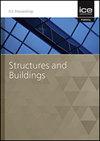Probabilistic seismic safety assessment of bridges with random pier scouring
IF 1.4
4区 工程技术
Q3 CONSTRUCTION & BUILDING TECHNOLOGY
Proceedings of the Institution of Civil Engineers-Structures and Buildings
Pub Date : 2023-08-01
DOI:10.1680/jstbu.23.00014
引用次数: 0
Abstract
Foundation scour has been a reason for several river-bridge earthquake-induced failure cases during recent decades. However, practicing engineers often do not consider its direct effect on the seismic design procedure of such structures. The cavity around a bridge foundation is a random phenomenon depending on several uncertain parameters. This study provides a probabilistic platform to investigate the effect of random scouring on the seismic performance of a particular bridge. The procedure was then implemented on an existing multi-span RC bridge. To this end, the Monte-Carlo simulation technique was utilized to generate the samples of the random variables of the scour model to develop the scour hazard curve. In this study, a common type of reinforced concrete multi-span bridge is considered as a model. The Latin hypercube sampling method was employed to generate random scouring scenarios in the finite-element model, including uniform and non-uniform scour. Then, Fragility curves were developed utilizing cloud dynamic analysis. The results revealed that the scouring pattern is one of the most crucial sources of uncertainty. In most circumstances, uniform scour scenarios are more effective than the average of non-uniform cases. However, in some specific patterns, the effect of non-uniform scouring is dominant.随机冲刷桥墩桥梁的概率地震安全性评估
近几十年来,基础冲刷已成为多起河桥地震破坏的主要原因。然而,实践工程师往往不考虑其对此类结构抗震设计过程的直接影响。桥梁基础周围的空腔是由若干不确定参数决定的随机现象。本研究为研究随机冲刷对特定桥梁抗震性能的影响提供了一个概率平台。然后在现有的多跨钢筋混凝土桥上实施了该程序。为此,利用蒙特卡罗模拟技术生成冲刷模型随机变量的样本,绘制冲刷危害曲线。本研究以一种常见的钢筋混凝土多跨桥梁为模型。采用拉丁超立方体抽样方法在有限元模型中生成均匀冲刷和非均匀冲刷两种随机冲刷情景。然后利用云动态分析,绘制脆弱性曲线。结果表明,冲刷模式是不确定性最重要的来源之一。在大多数情况下,均匀冲刷情况比平均非均匀冲刷情况更有效。然而,在某些特定的花型中,不均匀冲刷的影响是主要的。
本文章由计算机程序翻译,如有差异,请以英文原文为准。
求助全文
约1分钟内获得全文
求助全文
来源期刊
CiteScore
3.40
自引率
6.20%
发文量
61
审稿时长
12 months
期刊介绍:
Structures and Buildings publishes peer-reviewed papers on the design and construction of civil engineering structures and the applied research associated with such activities. Topics include the design, strength, durability and behaviour of structural components and systems.
Topics covered: energy conservation, people movement within and around buildings, strength and durability of steel and concrete structural components, and the behaviour of building and bridge components and systems

 求助内容:
求助内容: 应助结果提醒方式:
应助结果提醒方式:


